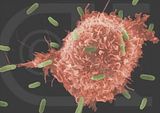
School:
Temasek Polytechnic
(Food Science & Nutrition)
Names
Alicia Chee(TA03)
Chin Ying(TA01)
Lynnette Heng(TA01)
Lorelle Ang(TA01)
Levina Tay(TA01)
Nicholas Tan(TA03)
Subject: PBPN
Topic:Immunology

Question 1
question 2
Question 2
question 3
Question 3
Question 3
Question 4
Question 4
Question 5
Question 5
Question 5


Bituwin,colorcodes - template
photobucket - image
Lupus is an autoimmune disease characterized by acute and chronic inflammation of various tissues of the body. Autoimmune diseases are illnesses that occur when the body's tissues are attacked by its own immune system. Lupus can cause disease of the skin, heart, lungs, kidneys, joints, and/or nervous system. When only the skin is involved, the condition is called Lupus dermatitis or Cutaneous lupus erythematosus. A form of lupus dermatitis that can be isolated to the skin, without internal disease, is called discoid lupus. When internal organs are involved, the condition is referred to as Systemic Lupus Erythematosus (SLE).The disease can affect all ages but most commonly begins from 20 to 45 years of age.
What are the signs and symptoms of lupus?
Patients with SLE can develop different symptoms such as: fatigue, low-grade fever, loss of appetite, muscle aches, arthritis, ulcers of the mouth and nose, facial rash ("butterfly rash"), unusual sensitivity to sunlight (photosensitivity), inflammation of the lining that surrounds the lungs (pleuritis) and the heart (pericarditis), and poor circulation to the fingers and toes with cold exposure (Raynaud's phenomenon). Complications of organ involvement can lead to further symptoms that depend on the organ affected and severity of the disease.
Skin manifestations are frequent in lupus and can sometimes lead to scarring. In discoid lupus, only the skin is typically involved. The skin rash in discoid lupus often is found on the face and scalp. It is usually red and may have raised borders. Discoid lupus rashes are usually painless and do not itch, but scarring can cause permanent hair loss. Over time, 5%-10% of patients with discoid lupus may develop SLE.
Over half of the patients with SLE develop a characteristic red, flat facial rash over the bridge of their nose. Because of its shape, it is frequently referred to as the "butterfly rash" of SLE. The rash is painless and does not itch. The facial rash, along with inflammation in other organs, can be precipitated or worsened by exposure to sunlight, a condition called photosensitivity. This photosensitivity can be accompanied by worsening of inflammation throughout the body, called a "flare" of the disease.
Reference
[Kathy Davis. Systemic Lupus Erythematosus. Retrieved Date: 5th Feb 2010. Website: http://www.connectedkansaskids.com/Diagnoses/SLE1.aspx ]
[abonzor100.(2009, April 24) 3D Animations of lupus [video file] Retrieved from http://www.youtube.com/watch?v=u-Em472khOY]
2 Comments:
Hey, nice blog you guys have here :)
But i have a few questions, since Lupus is a disease where the immune system attacks body cells and tissues; is the disease fatal? And what is the average lifespan of a person living with Lupus?
Also what lifestyle changes do you recommend for a person suffering from SLE?
Thank you.
By Rusnealz (Grp 3), at February 10, 2010 at 3:47 PM
hi! Thanks for your compliment on our blog =)The seriousness of the disease varies from different people.For some, it is mild for some it is very serious even leading to death.Those who have milder lupus, can sometimes have the same life span as a normal person - depending if there is any complications that arise at the same time e.g. kidney failures A person with lupus is more susceptable to infections, diseases and cancers.
Some of the lifestyle changes:
Avoid Sun Exposure- Sunlight will burn you easily, worsen lupus skin rashes, and may precipitate a flare-up of other symptoms. Use sun block lotion.
Treat All Cuts and Infections Quickly and Vigorously- Lupus is a disease of your immune system. Anything that stimulates the immune system can cause a flare-up of the disease.
Healthful diet- A healthful diet is one that is low in saturated fat and rich in whole grains, fruits, and vegetables which provide nutrients for the body to function properly and to help you manage lupus and its complications.
Limit
Emotional Stress- Feeling stressed can put extra burden on your body, including your immune system.
Get Adequate Rest- Many people with lupus get tired easily. Immune function, may be compromised if you do not get enough quality sleep. Strive for 7-8 hours of sleep per night, and take naps if you need them.
Exercise Moderately- Regular exercise helps keep you in good shape and better able to manage the affects of lupus.
Reference:
1. Ricker Polsdorfer, MD. (2009). Retrieved 12 Feb 2010, from Aurora Health Care. Website: http://www.aurorahealthcare.org/yourhealth/healthgate/getcontent.asp?URLhealthgate=%2219779.html%22
2. Harris ED, Budd RC, Genovese MC, Firestein GS, Sargent JS, Sledge CB. Kelley's Textbook of Rheumatology. 7th ed. St. Louis, Mo: WB Saunders; 2005. Website: http://www.lifespan.org/adam/healthillustratedencyclopedia/1/000435.html
3. Noble J. Textbook of Primary Care Medicine. 3rd ed. St. Louis, Mo: Mosby; 2001. Website: http://www.lifespan.org/adam/healthillustratedencyclopedia/1/000435.html
By mellitus-immunology, at February 12, 2010 at 1:21 AM

